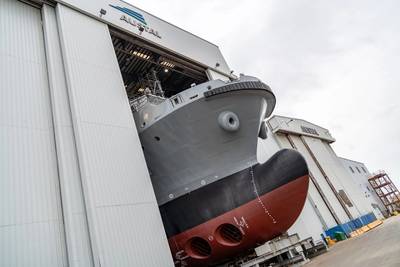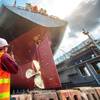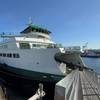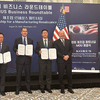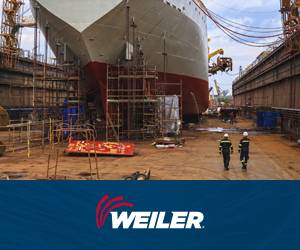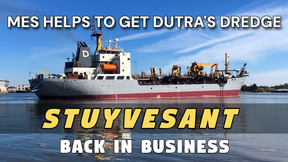U.S. Shipbuilding Plots the Path Ahead
The military and Coast Guard budgets are established that will benefit the U.S. ship building and repair sector, but what will stimulate the commercial yards?
This author has been scratching his head of late, after a thrilling dive into July’s U.S. Big Beautiful Bill Act, and has asked several colleagues where the funding for support commercial shipbuilding can be found? To answer that, we need to look elsewhere and to future programs.
Setting the Scene
Many column inches have been dedicated to the decline U.S. shipbuilding, whether signaled by the relatively small presence of a U.S. commercial fleet in international waters since the Civil War in the 1860s or the decline in yard capacity from after World War 2, where the Maritime Commission managed the delivery of ~5,800 mostly commercial ships and the navy 1,310 naval vessels between 1941-1945, reflecting America’s industrial prowess.
At the end of the 1930s, Great Britain, Central Europe and Scandinavian shipyards accounted for ~80% of all global deliveries (measured by compensated gross tonnes). The U.S. program during World War II replaced much of Britain’s lost capacity. After the war, British, western European and U.S. commercial yard capacity has reduced significantly, being replaced by the Japan, South Korea and increasingly China.
In 2024, China recorded a 54% shipyard market share (in output terms measured by compensated gross tonnes), South Korea 22%, Japan 12%, Europe 4% and 8% for a number of other countries, according to Clarksons Research.
Simply put, despite being a significant builder and repairer of naval vessels and Jones Act complaint vessels for the domestic market, the U.S. have been a minor player in the international commercial and specialist vessels shipbuilding market.
Restoring America’s Maritime Dominance
A key initiative of the current White House administration is the restoration of “America’s Maritime Dominance.
To support the initiative, the President Trump issued a key Executive Order in April 2025, demanding the creation of a maritime Action Plan (MAP) to revitalize U.S. maritime industries. Specific elements of the order include:
- Directing the Department of Defense to invest in and develop the Maritime Industrial Base (MIB) – the Big Beautiful Bill Act has allocated ~$33 billion to shipbuilding programs and technology and supply chain development.
- Instructing the United States Trade Representative (USTR) to recommend addressing China’s dominant shipbuilding position, following a public consultation on a range of issues including imposing fees “on every Chinese-built vessel that docks at a United States port.” This is probably the strongest lever to push companies to build vessels in the U.S.
- Establishing the Maritime Security Trust Fund “to provide consistent funding for maritime programs in addition to a shipbuilding financial incentives program to boost private investment in U.S. shipbuilding.”
- Increasing the fleet of commercial U.S. flag vessels trading internationally and domestically.
- Reestablishing the presence of the U.S. in the arctic (through building icebreakers). The Big Beautiful Bill Act has allocated ~$8.6 billion for icebreakers out of a $18.6 billion Coast Guard allocation.
- Investing $50 million of funding annually in 2026-2035 to expand the Maritime Innovation Program to support technology incubators and stakeholder partnerships focused on shipbuilding, alternative fuels, shoreside infrastructure, vessel design and naval architecture, and other areas identified as a priority by a Maritime Security Board.
Funding for some, but not all, of the above initiatives has been made available in the Big Beautiful Bill Act.
The initial importance of shipbuilding to the White House was reflected in the position of the National Security Council’s (NSC) Senior Director for the Office of Maritime and Industrial Capacity and NSC Chief of Staff in the White House. Under the Trump White House, this was the first time in recent administrations that the Office of Maritime and Industrial Capacity, supporting federal policy development and execution for shipbuilding, has been physically located at the White House. However, following the departure of some five out of seven senior staffers, it is understood that the shipbuilding activity will be moved out of the NSC to the Office of Management and Budget. It is unclear who is currently accountable for managing the development of the Executive Order. This reflects a potential loss of focus on commercial shipbuilding.
We look to the SHIPS Act for support for the commercial sector. L to R: Peter Duclos, his sister Carol Hegarty (CFO), and brother John Duclos (Co-President and Director of Operations) carry on the family business of boatbuilding in Massachusetts.
L to R: Peter Duclos, his sister Carol Hegarty (CFO), and brother John Duclos (Co-President and Director of Operations) carry on the family business of boatbuilding in Massachusetts.
Image courtesy Gladding-Hearn Shipbuilding
The One Big Beautiful Bill Act (July 2025)
The one Big Beautiful Bill Act contains plans for over $51 billion of shipbuilding funding for naval ($32.8bn) and Coast Guard ($18.6bn) ship building and repair programs. There are no specific provisions from commercial shipbuilding.
~70% of the budget allocations (~$36.5 billion) are planned for new naval and Coast Guard vessels. The prime naval contractors that will benefit from the naval allocation are Austal USA (Alabama), Fincantieri Marinette Marine (Wisconsin), General Dynamics Bath Iron Works (Maine), General Dynamics Electric Boat Works (Connecticut) and General Dynamics NASSCO (California), Huntington Ingalls Ingalls Shipbuilding (Missouri), Huntington Ingalls Newport News (Virginia). For the Coast Guard program, ECO-Bollinger’s United Shipbuilding Alliance, Gulf Copper-Davie and Hanwha Philly Shipyard are expected to benefit. At press time it was announced that Bollinger Shipyards, Rauma Shipyards, Seaspan Shipyards and Aker Arctic formed a partnership to deliver next-generation Arctic Security Cutters (ASCs) under the Coast Guard’s multibillion-dollar icebreaker program.
The focus of the navy budget is new ships and development of Industry 4.0 technology capabilities in the supply chain (AI, unmanned surface and subsurface vessels, additive manufacturing, etc.). The Coast Guard focus is building new cutters and icebreakers.
US$ million | Coast Guard | Navy | Total |
Building & repair capacity | - | 4,700 | 4,700 |
Cold ironing | - | 300 | 300 |
Manufacturing | - | 250 | 250 |
Ship procurement | - | 17,963 | 17,963 |
Steel & component production | - | 245 | 245 |
Systems | - | 80 | 80 |
Training & Development | - | 1,450 | 1,450 |
Cutting edge technologies | - | 1,692 | 1,692 |
Cutting edge technologies UASV & UASSSV | - | 5,546 | 5,546 |
Cutting edge technologies Additive manufacturing | - | 450 | 450 |
Cutting edge technologies (Indo Pacific Area) | - | 125 | 125 |
Building & repair capacity (Indo Pacific Area) | - | 19 | 19 |
Coast Guard cutter building | 14,178 | - | 14,178 |
Coast Guard building & repair capacity | 4,379 | - | 4,379 |
Total | 18,557 | 32,820 | 51,377 |
Source: Intelatus Global Partners interpretation of the provisions of the One Big Beautiful Bill Act
The structure of the budget infers that federal measures such as the SHIPS for America Act will provide the demand certainty for the private sector to invest in the U.S. commercial shipbuilding and operating segment.
The Shipbuilding and Harbor Infrastructure for Prosperity and Security (SHIPS) for America Act
Congress is currently debating the Bill, reintroduced in May 2025 (original submission is late 2024). The focus of the Bill reflects the aim spirit of the Executive Order to increase the U.S. flag fleet and revitalize the U.S. shipyard industrial base (shipyards and workforce). Key elements of the Bill that signal shipyard demand include:
- Growing the Strategic Commercial Fleet (SCF) from ~95 vessels to 250, with vessels built in the USA. Provisions include U.S. government financial assistance in the form of seven-year renewable contracts and no-fault termination payments of 100% of the ship value during construction.
- Repair of SCF ships in the USA.
The Big Beautiful Budget Bill Act does not have specific funding allocations for the future SHIPS programs.
 Image courtesy Thoma-Sea
Image courtesy Thoma-Sea
Smaller Shipyards Funding via MARAD
The U.S Department of Transport Maritime Administration (MARAD) administers federal funding for projects that align with the priorities of the federal administration. It should be noted that funding through MARAD appears somewhat limited at present and as such, start-ups and growing companies will still need to attract private sector investment.
MARAD had previously secured $8.75 million in funding for 2025 for the Small Shipyards Grant Program which provides up to 75% of project investment cost in yards with fewer than 1,200 employees. Grants have been announced for 17 yards to invest in facility upgrades:
Yard | State | Amount ($) | To support |
Master Boat Builder | Alabama | 427,596.38 | Training equipment & technologies |
Resolve Marine | Alaska | 447,341.00 | Equipment purchase |
Marine Group Boat Works | California | 248,402.50 | Metal cutting equipment investment |
Bay Ship & Yacht | California | 388,777.00 | Metal cutting equipment investment |
Eastern Shipbuilding | Florida | 93,537.75 | Metal cutting equipment investment |
St. John’s Ship Building | Florida | 617,040.00 | Crane investment |
JamesBuilt | Kentucky | 599,130.00 | Crane investment |
Breaux Bay Craft | Louisiana | 817,150.00 | Travelift investment |
PAR61 Marine Repair | Louisiana | 723,242.00 | Travelift upgrade investments |
Chesapeake Shipbuilding | Maryland | 817,150.00 | Crane investment |
Heartland Fabrication | Pennsylvania | 588,092.00 | Metal cutting equipment investment |
J. Goodson Company | Rhode Island | 274,596.00 | Welding equipment investment |
Conrad Orange Shipyard | Texas | 418,200.50 | Metal cutting equipment investment |
Ice Floe | Washington | 357,317.00 | Metal cutting and welding equipment investment |
Snow & Company | Washington | 817,150.00 | Metal press investment |
Lake Union Drydock | Washington | 298,131.64 | Crane investment |
Fraser Shipyards | Wisconsin | 817,146.23 | Crane investment |
Source: Intelatus Global Partners
The Federal Ship Financing Program (Title XI) exists to provide competitive financing for new vessel construction and shipyard investment, with project funded up to 87.5% of their value, a repayment term of up to 25 years and below market interest rates. However, the cancellation of the designation of Vessels of National Interest in April 2025 has removed a significant number of project applications submitted during the previous administration.
 Bollinger announced a partnership with Finland’s Rauma Shipyards, Canada’s Seaspan Shipyards and Finland’s Aker Artic to design and build the Coast Guard’s next generation Arctic Security Cutters (ASCs).
Bollinger announced a partnership with Finland’s Rauma Shipyards, Canada’s Seaspan Shipyards and Finland’s Aker Artic to design and build the Coast Guard’s next generation Arctic Security Cutters (ASCs).
Image courtesy SeaspanRecent Commercial Yard Investments and Initiatives
The changing political framework and trade tariff initiatives have trigged a wave of significant investment in U.S. Shipyards, which will see overseas companies investing in larger shipyards in the U.S.
Ahead of the current administration, Hanwha Systems and Hanwha Ocean closed the $100 million of what is now called Hanwha Philly Shipyard. The yard has already announced a contract to build an LNG carrier for delivery in 2028, although most of the U.S. flagged vessel will be physically built in the South Korea.
The South Korean Government has been developing a proposal with the U.S. to invest and modernize some U.S shipyard capacity and provide additional support for naval fleet repair.
HD Hyundai and Huntington Ingalls announced an MoU in April 2025 “to explore opportunities to collaborate on accelerating ship production in support of defense and commercial shipbuilding projects”. In June, HD Hyundai and Edison Chouest confirmed a partnership to build commercial vessels in the U.S, focusing on jointly building mid-sized containerships by 2028.
The U.S. and Japan have signed a trade and investment agreement that commits a part of $550 billion of investment to “Commercial and defense shipbuilding, including new yards and modernization of existing facilities”. The specific details of the agreement are to be developed.
Canada’s Davie further enhanced its role in icebreaker construction and the ability to align with U.S. Maritime Action Plan and the Ships for America Act through the 2025 announced acquisition of Gulf Copper’s yard in Texas, USA. Davie indicates that it intends to invest ~US$1 billion in the facilities and capabilities of the Gulf Copper yard.
In May 2025, Bollinger Shipyards and Edison Chouest announced the formation of the United Shipbuilding Alliance to design, construct and deliver the new generation of arctic icebreakers. At the end of July, Bollinger followed this initiative by announcing a partnership with Finland’s Rauma Shipyards, Canada’s Seaspan Shipyards and Finland’s Aker Artic to design and build the Coast Guard’s next generation Arctic Security Cutters (ASCs).
A Changing Environment
The foundations are being put in place to boost certain segments of U.S. shipbuilding, but it will result in the U.S. becoming a dominant player. For that, we still look eastwards to China, South Korea, Japan, Vietnam and emerging India.




